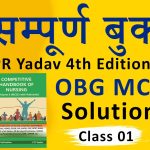ANM (Auxiliary Nurse Midwifery) exam is crucial for nursing aspirants. Preparing well with subject-wise questions and answers helps students understand the topics clearly. This guide provides comprehensive questions and answers for better preparation.
General Nursing Questions
Question: What is the normal blood pressure range for an adult?
Answer: The normal blood pressure range is 120/80 mmHg.
Question: What is the function of red blood cells?
Answer: Red blood cells transport oxygen to body tissues.
Question: Define asepsis in nursing.
Answer: Asepsis is the practice of preventing infections through sterilization and cleanliness.
Question: What is the normal pulse rate of an adult?
Answer: The normal pulse rate of an adult is 60-100 beats per minute.
Question: Name the instrument used to measure blood pressure.
Answer: A sphygmomanometer is used to measure blood pressure.
Question: What are the main components of blood?
Answer: The main components of blood are plasma, red blood cells, white blood cells, and platelets.
Question: How do you manage a patient with a fever?
Answer: Management includes monitoring temperature, providing fluids, and administering antipyretics as prescribed.
Question: What is the primary role of a midwife?
Answer: A midwife provides care to women during pregnancy, labor, and postpartum.
Question: What are the signs of dehydration?
Answer: Signs of dehydration include dry mouth, decreased urine output, dizziness, and dark-colored urine.
Question: Define immunity.
Answer: Immunity is the body’s ability to resist infections and diseases.
Question: What is a nosocomial infection?
Answer: A nosocomial infection is an infection acquired in a hospital setting.
Question: What are the common symptoms of diabetes?
Answer: Symptoms include frequent urination, increased thirst, and unexplained weight loss.
Question: What is the role of the placenta during pregnancy?
Answer: The placenta provides nutrients and oxygen to the fetus and removes waste.
Question: How is BMI calculated?
Answer: BMI is calculated as weight in kilograms divided by height in meters squared.
Question: What is the difference between sterile and clean techniques?
Answer: Sterile technique eliminates all microorganisms, while clean technique reduces the number of microorganisms.
Question: What are the five rights of medication administration?
Answer: The five rights are the right patient, right drug, right dose, right route, and right time.
Question: What is the normal respiratory rate for an adult?
Answer: The normal respiratory rate for an adult is 12-20 breaths per minute.
Question: Name a vitamin essential for blood clotting.
Answer: Vitamin K is essential for blood clotting.
Question: How do you manage a patient with hypoglycemia?
Answer: Management includes giving a quick source of sugar like juice or candy and monitoring blood glucose levels.
Midwifery Questions
Question: What is the average duration of pregnancy?
Answer: The average duration of pregnancy is 40 weeks.
Question: What is the first stage of labor?
Answer: The first stage of labor involves the dilation of the cervix.
Question: Define postpartum hemorrhage.
Answer: Postpartum hemorrhage is excessive bleeding after childbirth.
Question: What is the Apgar score?
Answer: The Apgar score assesses the newborn’s health based on heart rate, respiration, muscle tone, reflexes, and skin color.
Question: What is quickening in pregnancy?
Answer: Quickening is the first movement of the fetus felt by the mother.
Question: What is the primary role of folic acid in pregnancy?
Answer: Folic acid prevents neural tube defects in the fetus.
Question: What are Braxton Hicks contractions?
Answer: Braxton Hicks contractions are irregular, painless uterine contractions during pregnancy.
Question: What are the signs of labor?
Answer: Signs include regular contractions, water breaking, and cervical dilation.
Question: How is preeclampsia managed?
Answer: Management includes monitoring blood pressure, administering medications, and sometimes early delivery.
Question: What is a cesarean section?
Answer: A cesarean section is a surgical procedure to deliver a baby.
Question: What is the Lochia?
Answer: Lochia is postpartum vaginal discharge consisting of blood, mucus, and uterine tissue.
Question: Define eclampsia.
Answer: Eclampsia is a severe complication of pregnancy characterized by seizures in a preeclamptic patient.
Question: What is the role of oxytocin in labor?
Answer: Oxytocin stimulates uterine contractions during labor.
Question: What is an episiotomy?
Answer: An episiotomy is a surgical incision made in the perineum to aid childbirth.
Question: What are the signs of fetal distress?
Answer: Signs include abnormal heart rate, meconium-stained amniotic fluid, and reduced fetal movements.
Question: What is the normal fetal heart rate?
Answer: The normal fetal heart rate is 110-160 beats per minute.
Question: What is a breech presentation?
Answer: A breech presentation is when the fetus’s buttocks or feet are positioned to be delivered first.
Question: What are the benefits of breastfeeding?
Answer: Benefits include improved immunity for the baby and reduced risk of breast cancer for the mother.
Question: How is gestational diabetes diagnosed?
Answer: Gestational diabetes is diagnosed through glucose tolerance tests.
Community Health Questions
Question: What is the primary goal of community health nursing?
Answer: The goal is to promote and protect the health of populations.
Question: Define health promotion.
Answer: Health promotion involves activities that improve overall health and prevent diseases.
Question: What is the function of a health center?
Answer: A health center provides primary healthcare services to the community.
Question: What is the Expanded Program on Immunization (EPI)?
Answer: The EPI aims to immunize children against preventable diseases like polio and measles.
Question: What are the common waterborne diseases?
Answer: Common waterborne diseases include cholera, typhoid, and diarrhea.
Question: What is family planning?
Answer: Family planning involves strategies to control the number and timing of children in a family.
Question: Define malnutrition.
Answer: Malnutrition is a condition caused by inadequate or excessive intake of nutrients.
Question: What is herd immunity?
Answer: Herd immunity occurs when a large portion of the community becomes immune to a disease.
Question: What is the role of sanitation in health?
Answer: Sanitation prevents diseases by promoting hygiene and clean environments.
Question: What is the importance of vaccination?
Answer: Vaccination prevents the spread of infectious diseases and builds immunity.
Question: What is primary healthcare?
Answer: Primary healthcare addresses basic health needs and focuses on prevention and treatment.
Question: What are the causes of infant mortality?
Answer: Causes include infections, malnutrition, and poor prenatal care.
Question: How can anemia be prevented?
Answer: Anemia can be prevented by consuming iron-rich foods and taking iron supplements.
Question: What is the main symptom of tuberculosis?
Answer: The main symptom of tuberculosis is a persistent cough lasting more than two weeks.
Question: How is HIV transmitted?
Answer: HIV is transmitted through unprotected sex, contaminated needles, and from mother to child during childbirth or breastfeeding.
Question: What is a balanced diet?
Answer: A balanced diet contains all essential nutrients in appropriate proportions.
Question: What are the benefits of handwashing?
Answer: Handwashing reduces the spread of infections and maintains hygiene.
Question: What are the signs of malnutrition in children?
Answer: Signs include stunted growth, underweight, and weakened immunity.
Question: How is malaria prevented?
Answer: Malaria is prevented by using insecticide-treated nets, eliminating mosquito breeding sites, and taking antimalarial medications.
Preparing with these questions and answers helps ANM aspirants confidently approach their exams. Consistent practice and understanding of these concepts are essential for success in the field of nursing.
Latest Posts
- Step-by-step guide to download and apply for jee mains admit card 202
- Comprehensive 2025 government holidays and recruitment details for job seekers
- JEE Mains Admit Card 2025: Your Step-by-Step Guide to Downloading the Hall Ticket
- Everything You Need to Know About 2025 Government Holidays Recruitment
- Comprehensive Guide to rrb d group recruitment 2025 – Eligibility, Vacancies, and Application
- Detailed guide to nps trust recruitment 2025 vacancies, eligibility and apply process
- Comprehensive guide to hpcl recruitment 2025 notification, vacancies, and application process
- ignou bed admission 2025 complete recruitment guide with eligibility and process
- Comprehensive Guide to Indian Army Agniveer Recruitment 2025 Notification and Jobs
- Everything You Must Know About CBSE Board Exams 2025 Changes & New Rules




